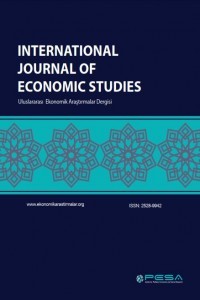The Major Drivers of Urban Growth in Developed Countries: Evidence from the G7
It is widely alleged that urbanization has gained momentum during the past 19th and 20th century in most of today’s developed countries. Today, these countries still displaying higher urban rates globally, are recorded a tremendous decline in urban growth. As the phenomenon has been less examined in the concerned countries in the 21st century compared to the previous centuries, this study proposes an analysis of selected economic, demographic and political variables in the process of urbanization occurring in the Group of seven (G7) countries. Data from the World Development Indicators and some other specialized institutions related to the G7 countries from 1995 to 2014 are employed to test the hypothesis that economic factors and international migration are the main engines of urban growth in the area. Results from panel data analysis using Fixed Effects estimations are used to test the hypothesized relationships. We found that higher productivity in manufacturing and increasing international migration flows are accelerating the pace of urban growth in G7 countries in the contemporary era.
Anahtar Kelimeler:
Drivers of Urban growth, G7 countries, Panel data, Fixed Effects Model, 21st century
___
- ANNA, C., & ANGELO, P. (2014). A Panel data approach to evaluate the Passenger Satisfaction of a Public Transport Service. Procedia Economics and Finance, 17, 231-237.
- BAIROCH, P., & GOERTZ, G. (1986). Factors of urbanization in the nineteenth century developed countries: a descriptive and econometric analysis. Urban Studies, 23(4), 285-305.
- BAIROCH, P. (1991). Cities and economic development: from the dawn of history to the present. University of Chicago Press.
- BALTAGI, B. H., & LEVIN, D. (1992). Cigarette taxation: raising revenues and reducing consumption. Structural Change and Economic Dynamics, 3(2), 321-335.
- BLOOM, D. E., SACHS, J. D. (1999). Geography, demography, and economic growth in Africa, in william C. Brainard and George l. Perry (eds.), Brookings Paper on Economic Activity 2: 1998. Washington, DC: The Brookings institution, pp. 207–295.
- BLOOM, D. E., CANNING, D., & Fink, G. (2008). Urbanization and the wealth of Nations. Science, 319(5864), 772-775.
- BRADSHAW, Y. W. (1987). Urbanization and underdevelopment: A global study of modernization, urban bias, and economic dependency. American Sociological Review, 224-239. CAMERON, R. E. (1993). A concise economic history of the world: from Paleolithic times to the present. Oxford University Press, USA.
- CRAFTS, N., & VENABLES, A. (2003). Globalization in history. A geographical perspective. In Globalization in historical perspective (pp. 323-370). University of Chicago Press.
- FAY, M., & OPAL, C. (2000). Urbanization without growth: A not so uncommon phenomenon (Vol. 2412). World Bank Publications.
- FEDERAL STATISTICAL OFFICE OF GERMANY. (2015). G7 in figures Summit of the G7 states in Elmau 2015.
- FOX, S. (2012). Urbanization as a global historical process: theory and evidence from sub-Saharan Africa. Population and Development Review, 38(2), 285-310.
- FOX, S. (2017). Mortality, migration and rural transformation in sub-Saharan Africa’s urban transition. Journal of Demographic Economics, vol 83., pp. 13-30
- GALLAWAY, L. E., & VEDDER, R. K. (1971). The increasing urbanization thesis-did" new immigrants" to the united states have a particular fondness for urban life? Explorations in Economic History, 8(3), 305.
- GALOR, O., & WEIL, D. N. (1999). From Malthusian stagnation to modern growth. American Economic Review, 89(2), 150-154. KASARDA, J. D., & CRENSHAW, E. M. (1991). Third world urbanization: Dimensions, theories, and determinants. Annual Review of Sociology, 17(1), 467-501.
- LIVI-BACCI, M. 2007. A Concise History of World Population, Fourth edition. oxford: Blackwell Publishing.
- MADDISON, A. (2007). Contours of the world economy 1-2030 AD: Essays in macro-economic history. Oxford University Press.
- MALIK, N., ASMI, F., ALI, M., & RAHMAN, M. M. (2017). Major Factors Leading Rapid Urbanization in China and Pakistan: A Comparative Study. Journal of Social Science Studies, 5(1), 148. NAMASAKA, M., & KAMARU, C. (2015). Is urbanization in sub-Saharan Africa divorced from economic growth?. Africa at LSE.
- ROYUELA, V., & Castells-Quintana, D. (2014). International migrations and urbanization: 1960–2010. International Journal of Global Environmental Issues, 13(2-4), 150-169.
- SZRETER, S. (1997). Economic growth, disruption, deprivation, disease, and death: on the importance of the politics of public health for development. Population and development review, 693-728.
- TORRES-REYNA, O. (2007). Panel data analysis fixed and random effects using Stata (v. 4.2). Data & Statistical Services, Princeton University.
- UNITED NATIONS DEPARTMENT OF ECONOMIC AND SOCIAL AFFAIRS, POPULATION DIVISION. (2014). World Urbanization Prospects: The 2014 Revision, Highlights (ST/ESA/SER.A/352).
- UNITED NATIONS DEPARTMENT OF ECONOMIC AND SOCIAL AFFAIRS, POPULATION DIVISION. (2017). World Population Prospects: The 2017 Revision, Volume I: Comprehensive Tables (ST/ESA/SER.A/399).
- ISSN: 2528-9942
- Başlangıç: 2015
- Yayıncı: Politik Ekonomik ve Sosyal Araştırmalar Merkezi
Sayıdaki Diğer Makaleler
The Major Drivers of Urban Growth in Developed Countries: Evidence from the G7
Ali KABASAKAL, Nadege Clemence Sourou Yabo AGOSSOU
Sosyal Güvenlik Bağlamında Türkiye ve Almanya'da Meslek Hastalığı
Kısa Vadeli Sermaye Akımlarının Vergilendirilmesi: Tobin Vergisi
Sermayeye Erişimde Eşitlik ve İktisadi Adalet: İkili Ekonomi Yaklaşımı
